A Data-Driven Adaptive Sampling Method Based on Edge Computing
Abstract
1. Introduction
2. Related Work
3. The Method of Data-driven Adaptive Data Acquisition Based on Edge Computing
3.1. Edge Data Acquisition Platform
- Uplink state data, data generated and collected during the production process of the product, including processing monitoring data, production environmental monitoring data and products quality feedback data.
- Downstream control data, data received by production equipment, including control data and configuration data for industrial equipment. Aiming at the collection and feedback of IIoT field data.
- Collection node: The collection node is used to collect data by various protocols on the industrial site. Through the sensing and collection of industrial field production data, the collection and transmission of equipment parameters and environmental data are realized.
- Edge gateway [26]: Edge gateway has the function of providing computing, storage, network and other infrastructure resources. Considering the complexity of communication connection among industry terminal equipment, edge gateway also requires the ability to have abundant interface/contracts. The edge gateway supports a variety of physical equipment protocol parsing and transformation, simple analysis, temporary storage and small batch data query. Edge gateway can transfer specific data to the management platform, realizing the communication between operation technology (OT) and information technology (IT).
- Management platform: The management platform is used to manage the edge gateway cluster, to set up the database cluster for the data uploaded by the edge device and to manage the data uniformly. The management platform provides a number of field-level applications to facilitate the management of production equipment. The long-term benefits, quantity and quality of information can be greatly improved through the establishment of the management platform.
3.2. Data-driven Adaptive Sampling Method
3.2.1. Establishment of Acquisition Process
3.2.2. Fitting of Regression Curve
3.2.3. Adaptive Sampling Strategy
4. Case Study
4.1. Improvement of Sampling Distortion
4.2. The Edge Data Redundancy
4.3. The Energy Consumption
5. Conclusions
Author Contributions
Funding
Acknowledgments
Conflicts of Interest
References
- Zhang, L.; Yuan, H.; Chang, S.-H.; Lam, A. Research on the overall architecture of Internet of Things middleware for intelligent industrial parks. Int. J. Adv. Manuf. Technol. 2020, 107, 1081–1089. [Google Scholar] [CrossRef]
- Rabeea, B.; Saad, Q.; Mudassar, A.; Monther, A.; Ikram, A.M.; Aamir, M.; Mikael, G. Fog Computing Enabling Industrial Internet of Things: State-of-the-Art and Research Challenges. Sensors 2019, 19, 4807. [Google Scholar]
- Mourtzis, D.; Vlachou, E.; Milas, N. Industrial Big Data as a Result of IoT Adoption in Manufacturing. Procedia CIRP 2016, 55, 290–295. [Google Scholar] [CrossRef]
- Plageras, A.P.; Psannis, K.E.; Stergiou, C.; Wang, H.; Gupta, B.B. Efficient IoT-based sensor BIG Data collection—processing and analysis in smart buildings. Future Gener. Comput. Syst. 2018, 82, 349–357. [Google Scholar] [CrossRef]
- Tong, X.; Yang, H.; Wang, L.; Miao, Y. The development and field evaluation of an IoT system of low-power vibration for bridge health monitoring. Sensors 2019, 19, 1222. [Google Scholar] [CrossRef]
- Geng, D.; Zhang, C.; Xia, C.; Xia, X.; Liu, Q.; Fu, X. Big Data-Based Improved Data Acquisition and Storage System for Designing Industrial Data Platform. IEEE Access 2019, 7, 44574–44582. [Google Scholar] [CrossRef]
- Tao, F.; Qi, Q.; Liu, A.; Kusiak, A. Data-driven smart manufacturing. J. Manuf. Syst. 2018, 48, 157–169. [Google Scholar] [CrossRef]
- Raposo, D.; Rodrigues, A.; Sinche, S.; Sá Silva, J.; Boavida, F. Industrial IoT monitoring: Technologies and architecture proposal. Sensors 2018, 18, 3568. [Google Scholar] [CrossRef]
- Evans, D. The internet of things: How the next evolution of the internet is changing everything. CISCO White Paper 2011, 1, 1–11. [Google Scholar]
- Yang, C.; Huang, Q.; Li, Z.; Liu, K.; Hu, F. Big Data and cloud computing: Innovation opportunities and challenges. Int. J. Digital Earth 2017, 10, 13–53. [Google Scholar] [CrossRef]
- Pan, J.; McElhannon, J. Future Edge Cloud and Edge Computing for Internet of Things Applications. IEEE Internet Things J. 2018, 5, 439–449. [Google Scholar] [CrossRef]
- Porambage, P.; Okwuibe, J.; Liyanage, M.; Ylianttila, M.; Taleb, T. Survey on Multi-Access Edge Computing for Internet of Things Realization. IEEE Commun. Surv. Tutor. 2018, 20, 2961–2991. [Google Scholar] [CrossRef]
- Chen, B.; Wan, J.; Celesti, A.; Li, D.; Abbas, H.; Zhang, Q. Edge Computing in IoT-Based Manufacturing. IEEE Commun. Mag. 2018, 56, 103–109. [Google Scholar] [CrossRef]
- Pereira, R.I.; Dupont, I.M.; Carvalho, P.C.; Jucá, S.C. IoT embedded linux system based on Raspberry Pi applied to real-time cloud monitoring of a decentralized photovoltaic plant. Measurement 2018, 114, 286–297. [Google Scholar] [CrossRef]
- Shi, W.; Cao, J.; Zhang, Q.; Li, Y.; Xu, L. Edge Computing: Vision and Challenges. IEEE Internet Things J. 2016, 3, 637–646. [Google Scholar] [CrossRef]
- Abbas, N.; Zhang, Y.; Taherkordi, A.; Skeie, T. Mobile Edge Computing: A Survey. IEEE Internet Things J. 2018, 5, 450–465. [Google Scholar] [CrossRef]
- Kumar, S.; Chaurasiya, V.K. A Strategy for Elimination of Data Redundancy in Internet of Things (IoT) Based Wireless Sensor Network (WSN). IEEE Syst. J. 2019, 13, 1650–1657. [Google Scholar] [CrossRef]
- Siddique, C.; Ban, X. State-dependent self-adaptive sampling (SAS) method for vehicle trajectory data. Transp. Res. Part C Emerg. Technol. 2019, 100, 224–237. [Google Scholar] [CrossRef]
- Scarabottolo, I.; Alippi, C.; Roveri, M. A spectrum-based adaptive sampling algorithm for smart sensing. In Proceedings of the IEEE SmartWorld, Ubiquitous Intelligence & Computing, Advanced & Trusted Computed, Scalable Computing & Communications, Cloud & Big Data Computing, Internet of People and Smart City Innovation (SmartWorld/SCALCOM/UIC/ATC/CBDCom/IOP/SCI), San Francisco, CA, USA, 4–8 August 2017; pp. 1–8. [Google Scholar]
- Xiao, J.; Rong, J.; Ye, W.; Zhang, C. An efficient adaptive frequency sampling scheme for large-scale transient boundary element analysis. Comput. Struct. 2016, 167, 86–95. [Google Scholar] [CrossRef]
- Zhang, W.; Xie, S. Piece-wise vector fitting method with binary frequency domain partitioning algorithm for automatic modeling. In Proceedings of the IEEE International Conference on Microwave and Millimeter Wave Technology (ICMMT), Beijing, China, 5–8 June 2016; pp. 363–365. [Google Scholar]
- Sun, Y.; Yuan, Y.; Li, X.; Xu, Q.; Guan, X. An Adaptive Sampling Algorithm for Target Tracking in Underwater Wireless Sensor Networks. IEEE Access 2018, 6, 68324–68336. [Google Scholar] [CrossRef]
- Shu, T.; Xia, M.; Chen, J.; De Silva, C. An energy efficient adaptive sampling algorithm in a sensor network for automated water quality monitoring. Sensors 2017, 17, 2551. [Google Scholar] [CrossRef] [PubMed]
- Drira, W.; Ahn, K.; Rakha, H.; Filali, F. Development and Testing of a 3G/LTE Adaptive Data Collection System in Vehicular Networks. IEEE Transact. Intell. Transp. Syst. 2016, 17, 240–249. [Google Scholar] [CrossRef]
- Yu, W.; Liang, F.; He, X.; Hatcher, W.G.; Lu, C.; Lin, J.; Yang, X. A Survey on the Edge Computing for the Internet of Things. IEEE Access 2018, 6, 6900–6919. [Google Scholar] [CrossRef]
- Morabito, R.; Petrolo, R.; Loscri, V.; Mitton, N. LEGIoT: A lightweight edge gateway for the Internet of Things. Future Gener. Comput. Syst. 2018, 81, 1–15. [Google Scholar] [CrossRef]
- Bhuiyan, M.Z.A.; Wu, J.; Wang, G.; Wang, T.; Hassan, M.M. e-sampling: Event-sensitive autonomous adaptive sensing and low-cost monitoring in networked sensing systems. ACM Transact. Auton. Adapt. Syst. 2017, 12, 1. [Google Scholar] [CrossRef]
- Sałuch, M.; Tokarski, D.; Grudniewski, T.; Chodyka, M.; Nitychoruk, J.; Woliński, P.; Jaworska, B.; Adamczewski, G. Raspberry PI 3B + microcomputer as a central control unit in intelligent building automation management systems. MATEC Web Conf. 2018, 196, 04032. [Google Scholar] [CrossRef][Green Version]
- Sethuraman, C.; Jood, P.; Srinivas, K. Remote Monitoring Energy Management System using LonWorks and Modbus Communication Protocol. Energy 2015, 2, 1654–1658. [Google Scholar]
- Yang, Y.; Cao, Q.; Jiang, H. EdgeDB: An Efficient Time-Series Database for Edge Computing. IEEE Access 2019, 7, 142295–142307. [Google Scholar] [CrossRef]
- Taherizadeh, S.; Stankovski, V.; Grobelnik, M. A capillary computing architecture for dynamic internet of things: Orchestration of microservices from edge devices to fog and cloud providers. Sensors 2018, 18, 2938. [Google Scholar] [CrossRef]
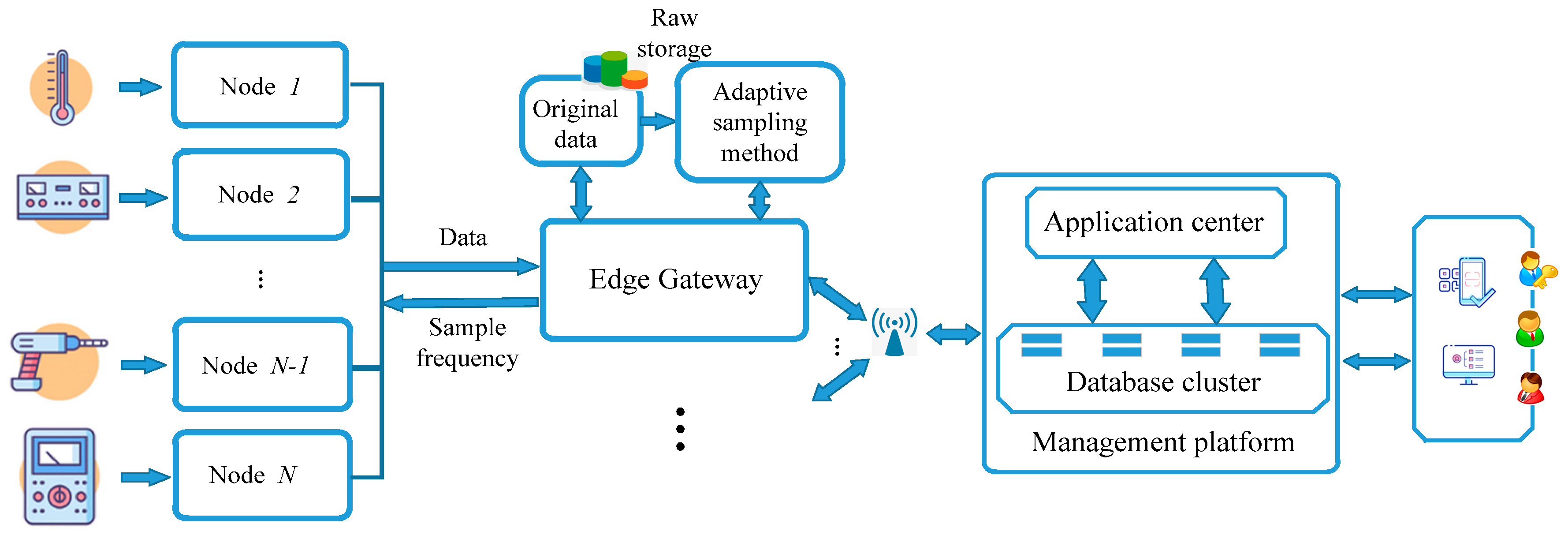


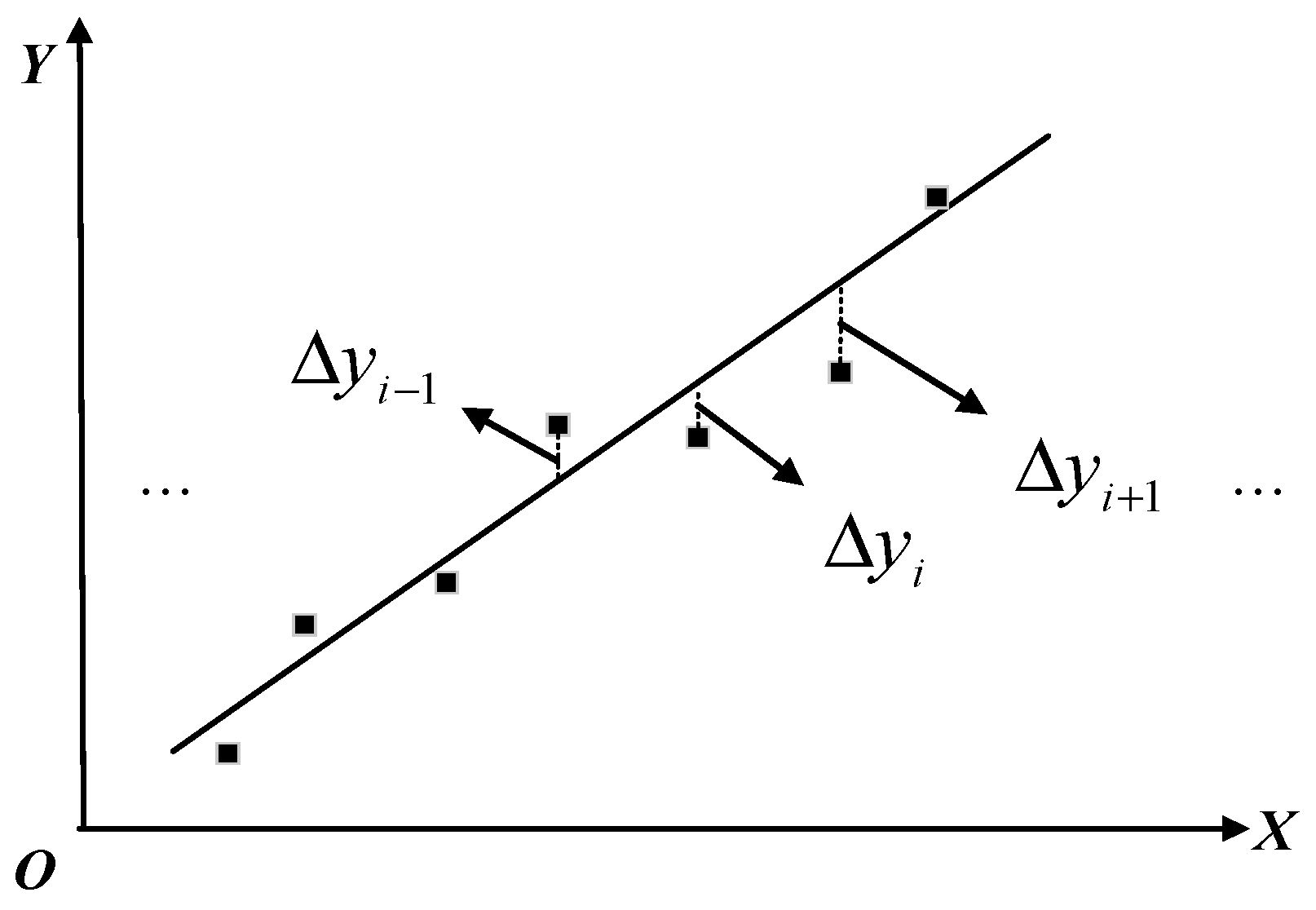
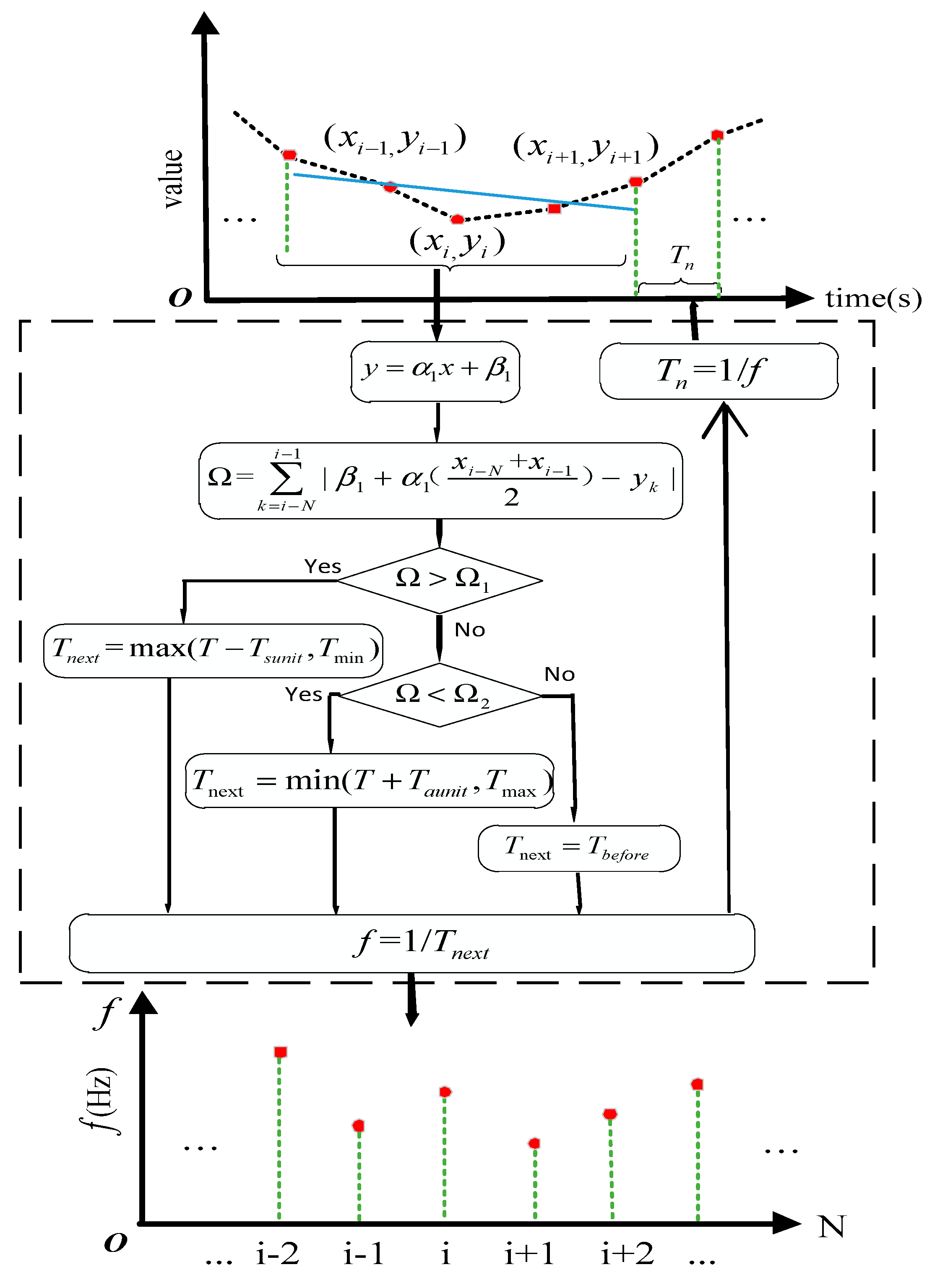


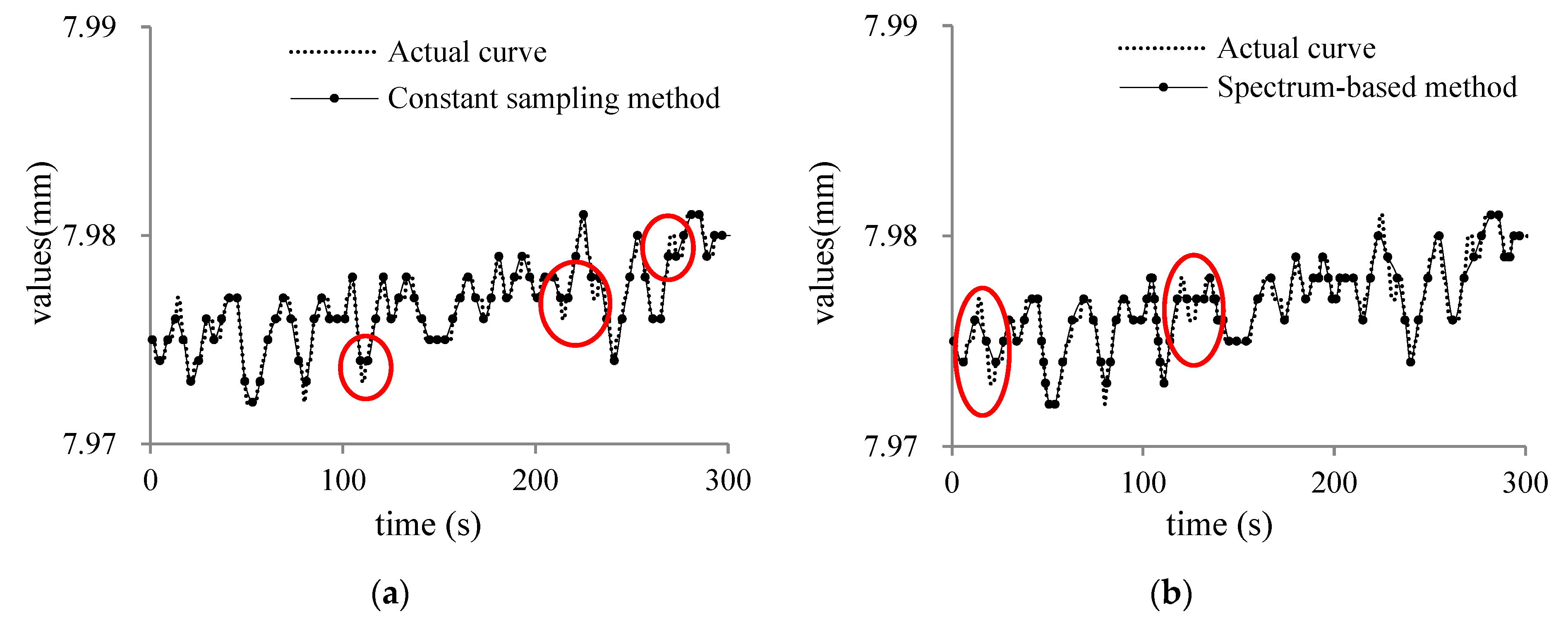
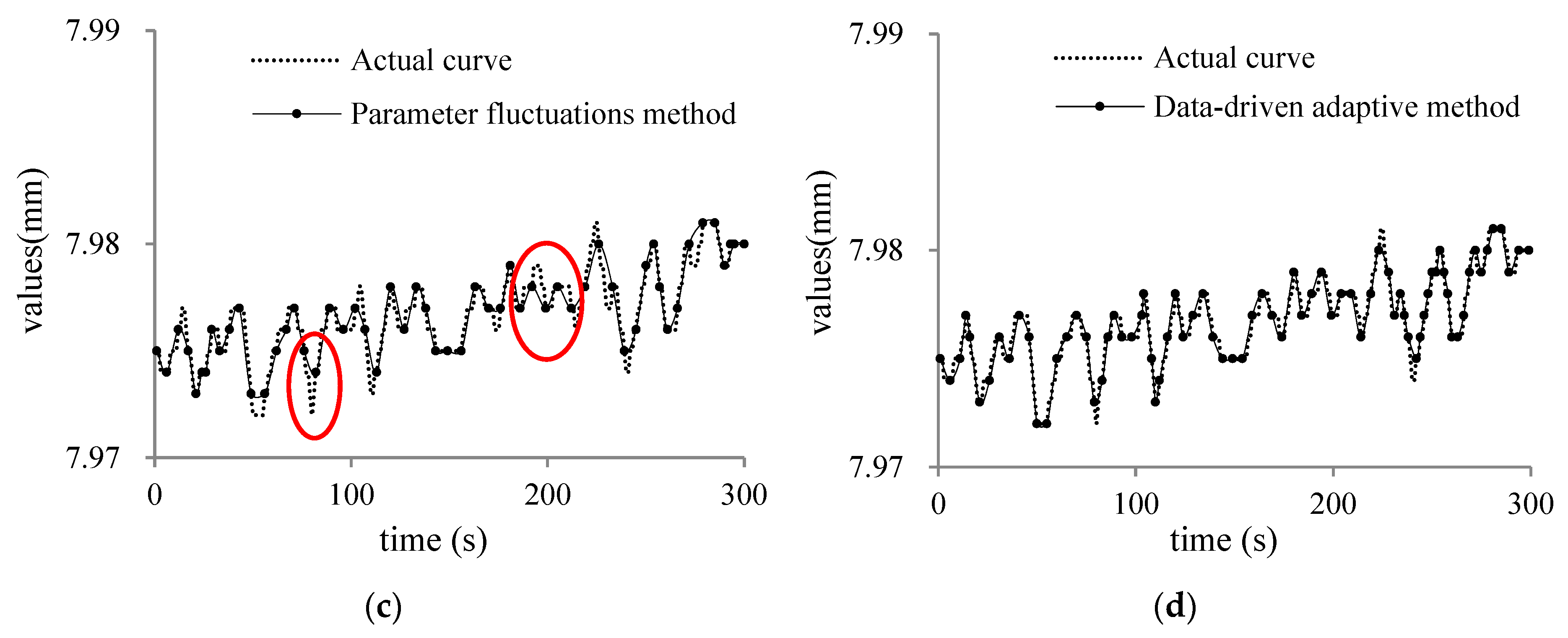
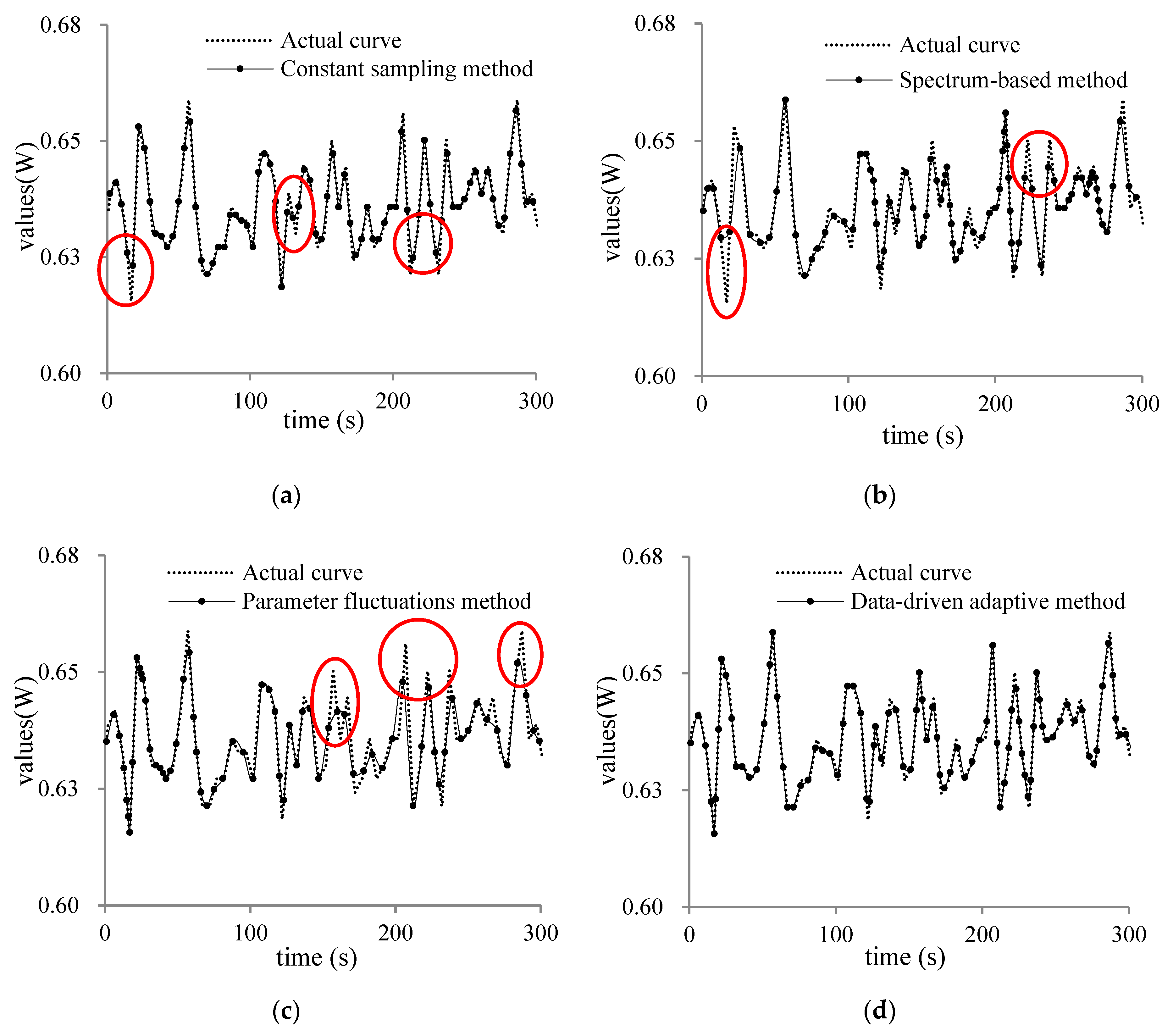

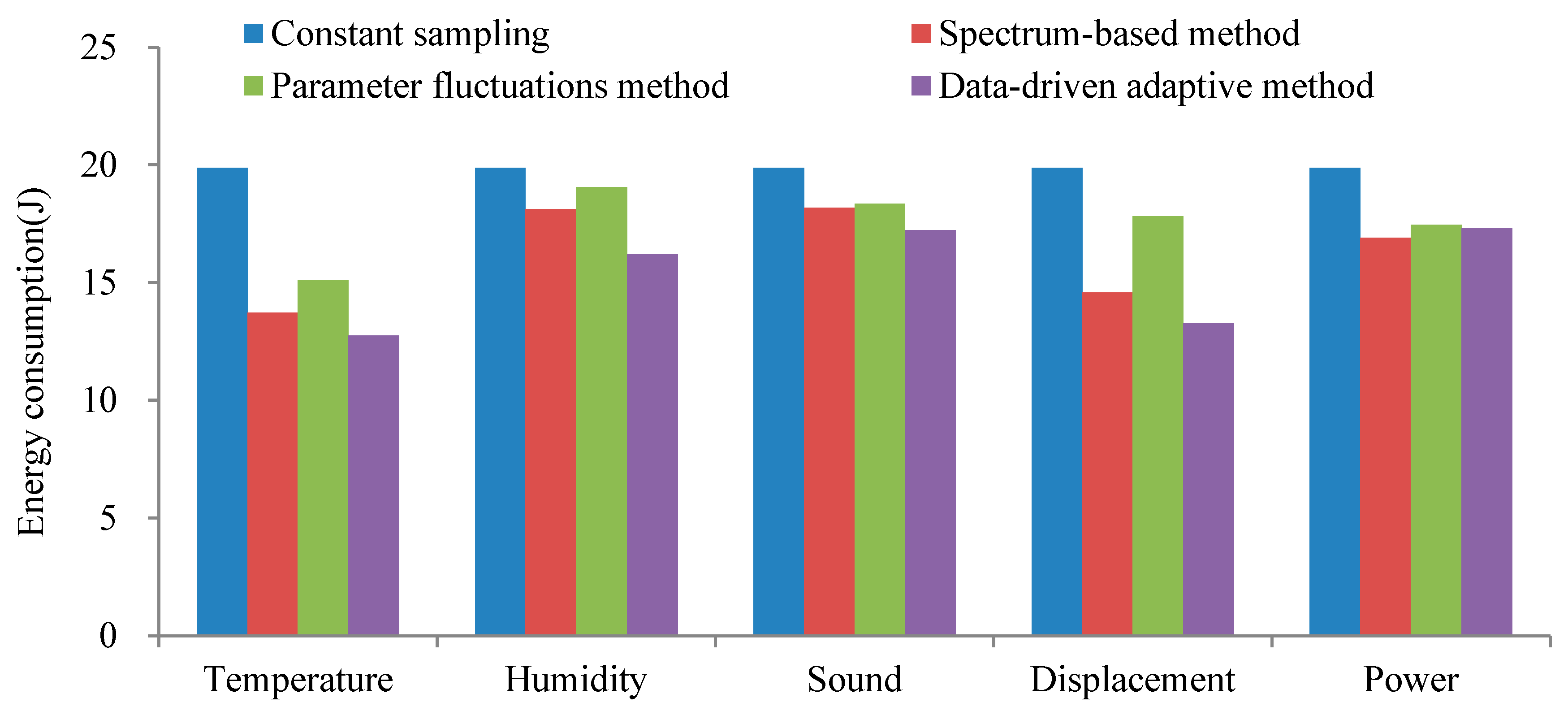
| Spectrum-Based | Parameter Fluctuations | Data-Driven | |
|---|---|---|---|
| Accuracy | √ | √ | |
| Rapid response | √ | √ | |
| Feasibility of edge device | √ | √ |
| Number of Nodes | Number of Sensors in a Single Node | Total | |
|---|---|---|---|
| Temperature sensor | 16 | 8 | 128 |
| Humidity sensor | 2 | 1 | 2 |
| Sound sensor | 1 | 2 | 2 |
| Displacement sensor | 1 | 3 | 3 |
| Power sensor | 1 | 3 | 3 |
| Temperature | Humidity | Sound | Displacement | Power | |
|---|---|---|---|---|---|
| Number | 3686400 | 57600 | 57600 | 86400 | 86400 |
| Node | 1 | 2 | 3 | 4 | 5 | 6 | 7 | 8 |
| Constant sampling | 14400 | 14400 | 14400 | 14400 | 14400 | 14400 | 14400 | 14400 |
| Spectrum-based | 9984 | 9874 | 10122 | 9857 | 10063 | 10008 | 9992 | 10206 |
| Parameter fluctuations | 11809 | 11058 | 10868 | 11399 | 12276 | 11752 | 11625 | 11314 |
| Data-driven | 9648 | 9254 | 9462 | 9545 | 10636 | 10502 | 9292 | 9440 |
| Decrease | 33.00% | 35.74% | 34.29% | 33.72% | 26.14% | 27.07% | 35.47% | 34.44% |
| Node | 9 | 10 | 11 | 12 | 13 | 14 | 15 | 16 |
| Constant sampling | 14400 | 14400 | 14400 | 14400 | 14400 | 14400 | 14400 | 14400 |
| Spectrum-based | 11086 | 11321 | 11632 | 10012 | 9971 | 10282 | 9521 | 9597 |
| Parameter fluctuations | 12541 | 12360 | 12888 | 12932 | 11187 | 12406 | 12254 | 12030 |
| Data-driven | 11089 | 10049 | 11669 | 9921 | 9310 | 9697 | 9215 | 9209 |
| Decrease | 22.99% | 30.22% | 18.97% | 31.10% | 35.35% | 32.66% | 36.01% | 36.05% |
© 2020 by the authors. Licensee MDPI, Basel, Switzerland. This article is an open access article distributed under the terms and conditions of the Creative Commons Attribution (CC BY) license (http://creativecommons.org/licenses/by/4.0/).
Share and Cite
Lou, P.; Shi, L.; Zhang, X.; Xiao, Z.; Yan, J. A Data-Driven Adaptive Sampling Method Based on Edge Computing. Sensors 2020, 20, 2174. https://doi.org/10.3390/s20082174
Lou P, Shi L, Zhang X, Xiao Z, Yan J. A Data-Driven Adaptive Sampling Method Based on Edge Computing. Sensors. 2020; 20(8):2174. https://doi.org/10.3390/s20082174
Chicago/Turabian StyleLou, Ping, Liang Shi, Xiaomei Zhang, Zheng Xiao, and Junwei Yan. 2020. "A Data-Driven Adaptive Sampling Method Based on Edge Computing" Sensors 20, no. 8: 2174. https://doi.org/10.3390/s20082174
APA StyleLou, P., Shi, L., Zhang, X., Xiao, Z., & Yan, J. (2020). A Data-Driven Adaptive Sampling Method Based on Edge Computing. Sensors, 20(8), 2174. https://doi.org/10.3390/s20082174





